PACC6008: Wage and Education Analysis & Housing Price Comparison
VerifiedAdded on 2023/06/12
|9
|1364
|69
Homework Assignment
AI Summary
This assignment focuses on business decision-making through statistical analysis. It examines US worker wages and education levels for 2018, employing descriptive statistics and graphical representations to analyze wage distributions and education levels. Hypothesis testing is conducted to determine if the proportion of workers with tertiary education has increased and whether average hourly wages have changed from 2017. The assignment further compares housing prices in New Town and Hurstville, using a t-test to assess whether there's a significant difference. The analysis concludes with recommendations for buyers based on budget considerations. Desklib offers a wealth of resources, including past papers and solved assignments, to aid students in understanding and mastering such analytical tasks.
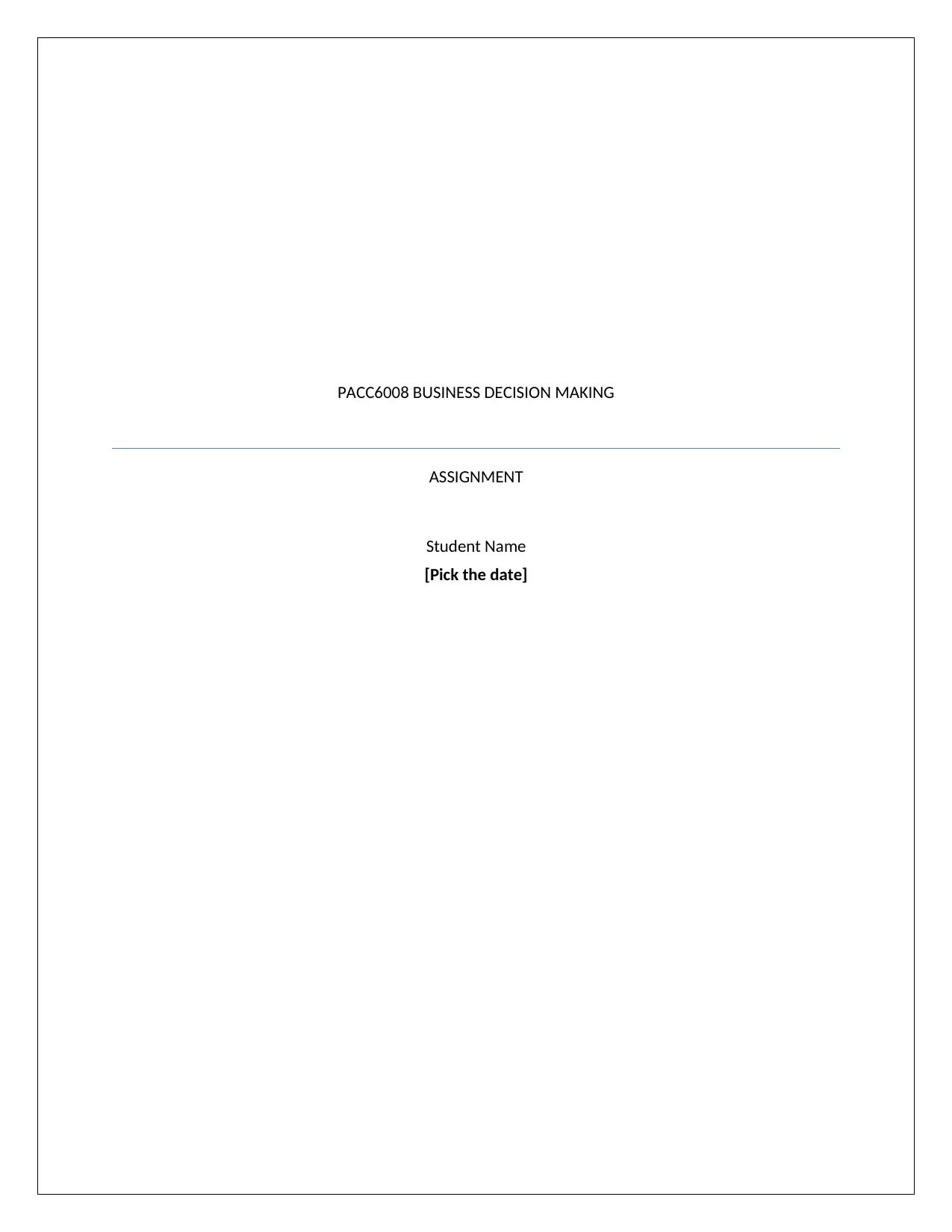
PACC6008 BUSINESS DECISION MAKING
ASSIGNMENT
Student Name
[Pick the date]
ASSIGNMENT
Student Name
[Pick the date]
Paraphrase This Document
Need a fresh take? Get an instant paraphrase of this document with our AI Paraphraser

Question 1
(1) The given institute seems to be interested in the US worker wages for the year 2018
(2) The relevant descriptive statistics for the given variables i.e. wage and education is as
illustrated below.
Numerical summary
The relevant graphical representation of the two data is as highlighted below.
1
(1) The given institute seems to be interested in the US worker wages for the year 2018
(2) The relevant descriptive statistics for the given variables i.e. wage and education is as
illustrated below.
Numerical summary
The relevant graphical representation of the two data is as highlighted below.
1
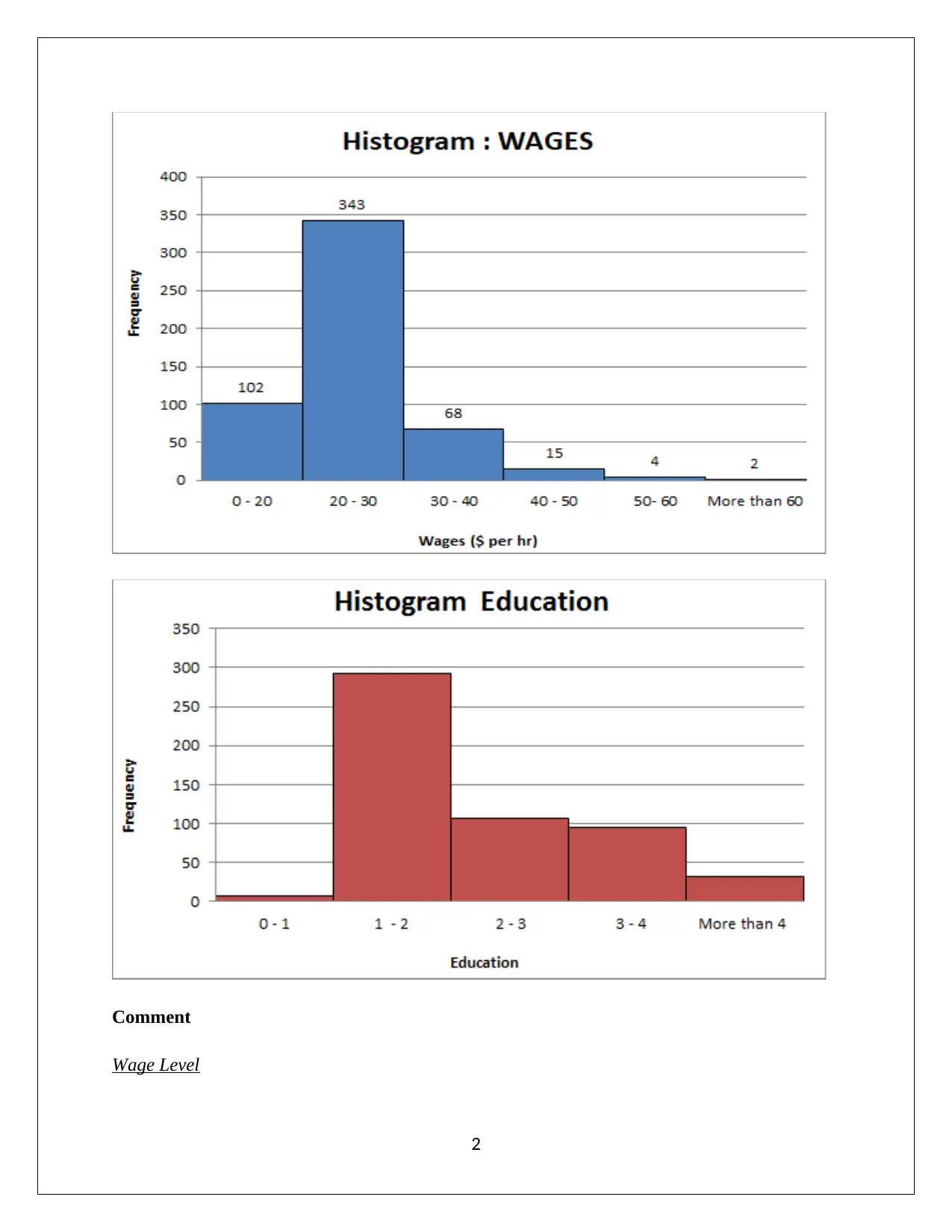
Comment
Wage Level
2
Wage Level
2
⊘ This is a preview!⊘
Do you want full access?
Subscribe today to unlock all pages.

Trusted by 1+ million students worldwide

The mean hourly wage level for the sample is $ 25.62. Considering the high amount of positive
skew in this sample data, the central tendency would be better captured using the median value
of $ 23.75 which tends to be immune to the extreme values. Besides, owing to the non-
coincidence of the measures of central tendency along with skew being non-zero, it would be
appropriate to conclude that the probability distribution of hourly wages is non-normal (Flick,
2015). Also, the shape of the graph would be asymmetric with a rightward tail as apparent from
the histogram. Besides, the hourly wage level has a high range as it varies from a minimum level
of $ 10 an hour to as high as $ 70 per hour. The standard deviation indicates that the dispersion is
moderate (Eriksson & Kovalainen, 2015).
Education Level
The average education level is indicated 2.73 but the median level is 2 which imply that 50% of
the individuals in the provided sample data would have received education no higher than
secondary level. Also, there is presence of positive skew using to individuals in the sample
having tertiary education which results in shape of graph being non-symmetric and also the
distribution being non-normal (Hair et. al, 2015). Dispersion in the given data is highlighted
through the use of values ranging 1 to 5 highlighted education level from primary to PHD.
(3) The historical proportion of workers having tertiary education (representing bachelor and
above) was 0.45 and it needs to be ascertained using the given data whether there has
been an increase in this regards through the use of hypothesis testing. The relevant
hypotheses to be considered for this test are as follows.
Null hypothesis H0 : p ≤ 0.45
Alternative hypothesis H1 : p> 0.45
The output obtained from excel in relation to the given hypothesis testing is attached below.
3
skew in this sample data, the central tendency would be better captured using the median value
of $ 23.75 which tends to be immune to the extreme values. Besides, owing to the non-
coincidence of the measures of central tendency along with skew being non-zero, it would be
appropriate to conclude that the probability distribution of hourly wages is non-normal (Flick,
2015). Also, the shape of the graph would be asymmetric with a rightward tail as apparent from
the histogram. Besides, the hourly wage level has a high range as it varies from a minimum level
of $ 10 an hour to as high as $ 70 per hour. The standard deviation indicates that the dispersion is
moderate (Eriksson & Kovalainen, 2015).
Education Level
The average education level is indicated 2.73 but the median level is 2 which imply that 50% of
the individuals in the provided sample data would have received education no higher than
secondary level. Also, there is presence of positive skew using to individuals in the sample
having tertiary education which results in shape of graph being non-symmetric and also the
distribution being non-normal (Hair et. al, 2015). Dispersion in the given data is highlighted
through the use of values ranging 1 to 5 highlighted education level from primary to PHD.
(3) The historical proportion of workers having tertiary education (representing bachelor and
above) was 0.45 and it needs to be ascertained using the given data whether there has
been an increase in this regards through the use of hypothesis testing. The relevant
hypotheses to be considered for this test are as follows.
Null hypothesis H0 : p ≤ 0.45
Alternative hypothesis H1 : p> 0.45
The output obtained from excel in relation to the given hypothesis testing is attached below.
3
Paraphrase This Document
Need a fresh take? Get an instant paraphrase of this document with our AI Paraphraser
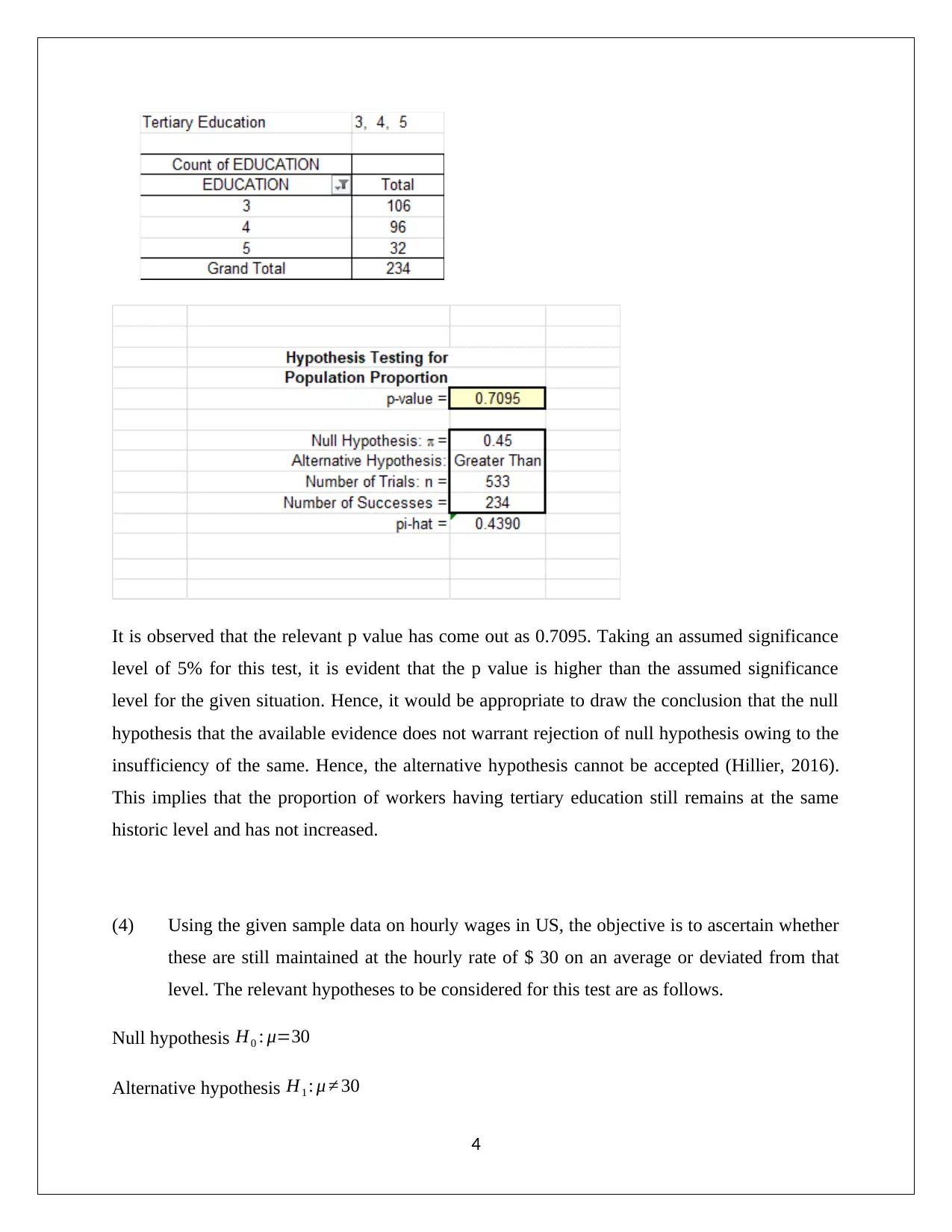
It is observed that the relevant p value has come out as 0.7095. Taking an assumed significance
level of 5% for this test, it is evident that the p value is higher than the assumed significance
level for the given situation. Hence, it would be appropriate to draw the conclusion that the null
hypothesis that the available evidence does not warrant rejection of null hypothesis owing to the
insufficiency of the same. Hence, the alternative hypothesis cannot be accepted (Hillier, 2016).
This implies that the proportion of workers having tertiary education still remains at the same
historic level and has not increased.
(4) Using the given sample data on hourly wages in US, the objective is to ascertain whether
these are still maintained at the hourly rate of $ 30 on an average or deviated from that
level. The relevant hypotheses to be considered for this test are as follows.
Null hypothesis H0 : μ=30
Alternative hypothesis H1 : μ ≠ 30
4
level of 5% for this test, it is evident that the p value is higher than the assumed significance
level for the given situation. Hence, it would be appropriate to draw the conclusion that the null
hypothesis that the available evidence does not warrant rejection of null hypothesis owing to the
insufficiency of the same. Hence, the alternative hypothesis cannot be accepted (Hillier, 2016).
This implies that the proportion of workers having tertiary education still remains at the same
historic level and has not increased.
(4) Using the given sample data on hourly wages in US, the objective is to ascertain whether
these are still maintained at the hourly rate of $ 30 on an average or deviated from that
level. The relevant hypotheses to be considered for this test are as follows.
Null hypothesis H0 : μ=30
Alternative hypothesis H1 : μ ≠ 30
4
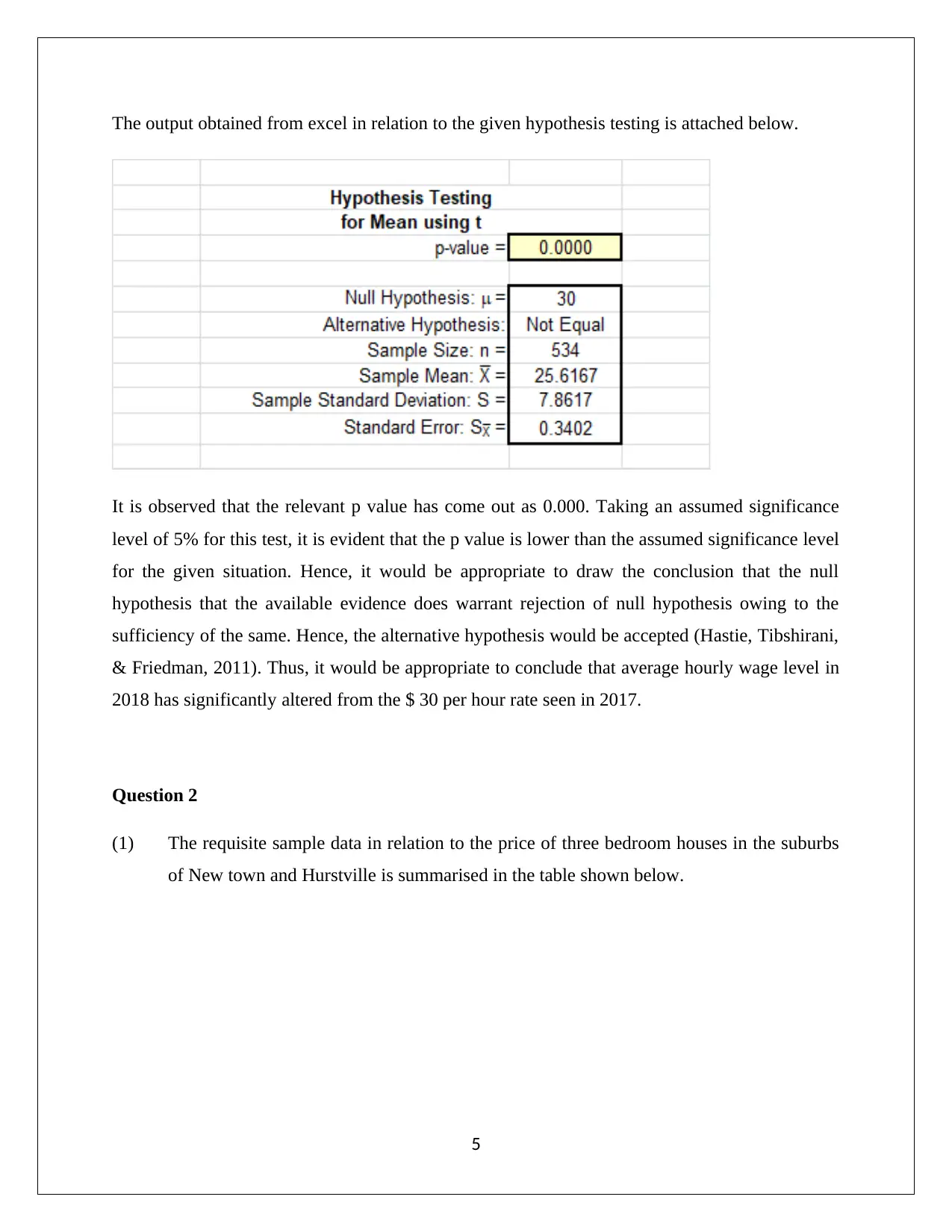
The output obtained from excel in relation to the given hypothesis testing is attached below.
It is observed that the relevant p value has come out as 0.000. Taking an assumed significance
level of 5% for this test, it is evident that the p value is lower than the assumed significance level
for the given situation. Hence, it would be appropriate to draw the conclusion that the null
hypothesis that the available evidence does warrant rejection of null hypothesis owing to the
sufficiency of the same. Hence, the alternative hypothesis would be accepted (Hastie, Tibshirani,
& Friedman, 2011). Thus, it would be appropriate to conclude that average hourly wage level in
2018 has significantly altered from the $ 30 per hour rate seen in 2017.
Question 2
(1) The requisite sample data in relation to the price of three bedroom houses in the suburbs
of New town and Hurstville is summarised in the table shown below.
5
It is observed that the relevant p value has come out as 0.000. Taking an assumed significance
level of 5% for this test, it is evident that the p value is lower than the assumed significance level
for the given situation. Hence, it would be appropriate to draw the conclusion that the null
hypothesis that the available evidence does warrant rejection of null hypothesis owing to the
sufficiency of the same. Hence, the alternative hypothesis would be accepted (Hastie, Tibshirani,
& Friedman, 2011). Thus, it would be appropriate to conclude that average hourly wage level in
2018 has significantly altered from the $ 30 per hour rate seen in 2017.
Question 2
(1) The requisite sample data in relation to the price of three bedroom houses in the suburbs
of New town and Hurstville is summarised in the table shown below.
5
⊘ This is a preview!⊘
Do you want full access?
Subscribe today to unlock all pages.

Trusted by 1+ million students worldwide
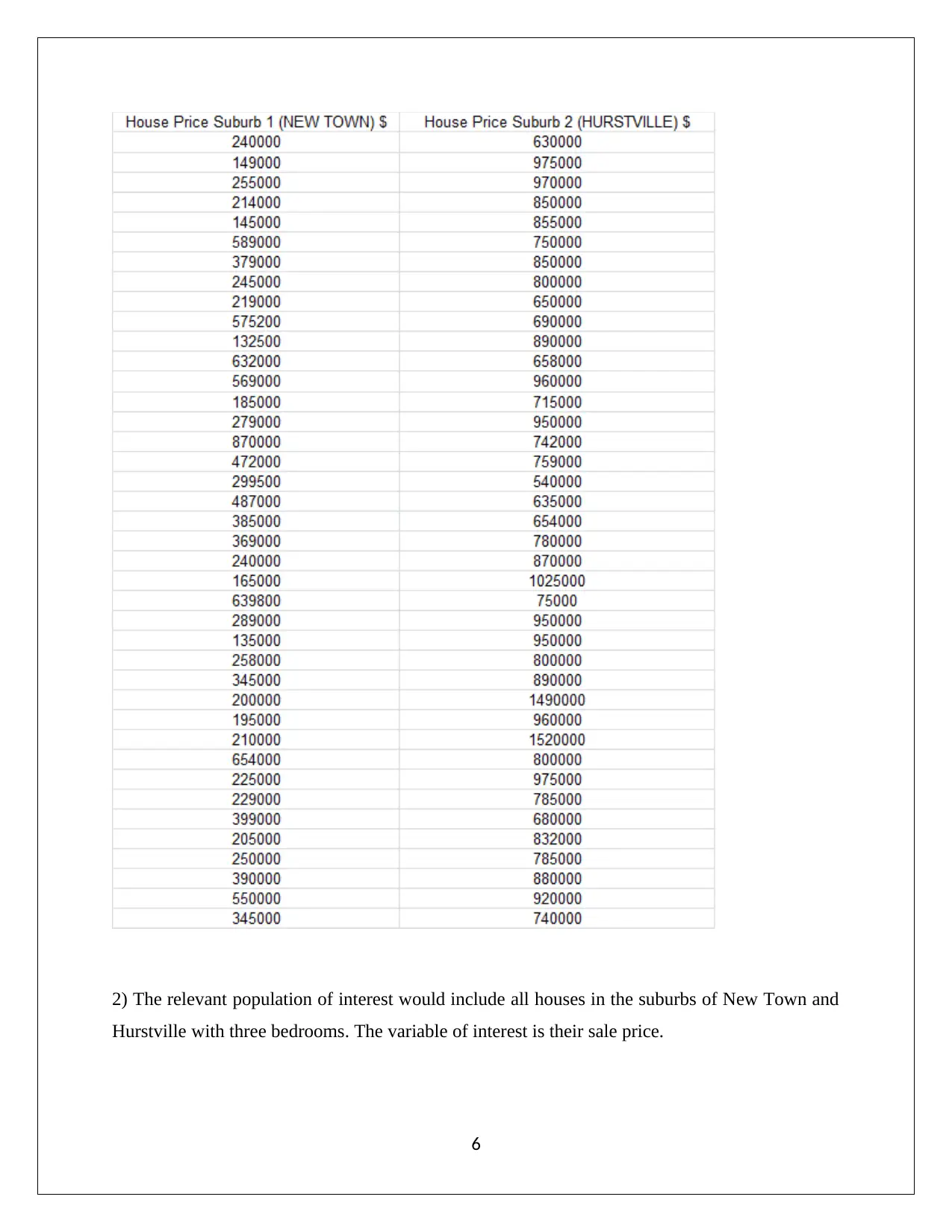
2) The relevant population of interest would include all houses in the suburbs of New Town and
Hurstville with three bedrooms. The variable of interest is their sale price.
6
Hurstville with three bedrooms. The variable of interest is their sale price.
6
Paraphrase This Document
Need a fresh take? Get an instant paraphrase of this document with our AI Paraphraser

3) Using the provided sample data, the task is to opine if the prices of three bedroom houses in
the two given suburbs differ from each other or not. The following hypotheses are used for
testing.
Null Hypothesis (H0): μNewTown = μHurstville i.e. the house prices in the given two suburbs for the
three bedroom houses do not tend to differ in a manner that is statistically significant
Alternative Hypothesis (H1): μNewTown ≠ μHurstville i.e. the house prices in the given two suburbs for
the three bedroom houses do tend to differ in a manner that is statistically significant
Considering that for both variables, the population standard deviation is unknown, hence z test
cannot be used and t test is the more appropriate choice.. Further, considering there are two
independent samples involves, hence a two tail two independent sample t test has to be
conducted for the testing of the hypothesis (Koch, 2013).The output obtained from excel in
relation to the given hypothesis testing is attached below.
The relevant p value (i.e. two tail) is 0.00. Taking an assumed significance level of 5% for this
test, it is evident that the p value is lower than the assumed significance level for the given
situation. Hence, it would be appropriate to draw the conclusion that the null hypothesis that the
available evidence does warrant rejection of null hypothesis owing to the sufficiency of the
same. Hence, the alternative hypothesis would be accepted (Fehr & Grossman, 2013).
4) The appropriate conclusion which may be drawn from the above hypothesis test is that the
prices of three bedroom houses in the two suburbs (i.e. New Town and Hurstville) tend to differ
and thus, a given buyer should choose the suburb in accordance with the budget available.
7
the two given suburbs differ from each other or not. The following hypotheses are used for
testing.
Null Hypothesis (H0): μNewTown = μHurstville i.e. the house prices in the given two suburbs for the
three bedroom houses do not tend to differ in a manner that is statistically significant
Alternative Hypothesis (H1): μNewTown ≠ μHurstville i.e. the house prices in the given two suburbs for
the three bedroom houses do tend to differ in a manner that is statistically significant
Considering that for both variables, the population standard deviation is unknown, hence z test
cannot be used and t test is the more appropriate choice.. Further, considering there are two
independent samples involves, hence a two tail two independent sample t test has to be
conducted for the testing of the hypothesis (Koch, 2013).The output obtained from excel in
relation to the given hypothesis testing is attached below.
The relevant p value (i.e. two tail) is 0.00. Taking an assumed significance level of 5% for this
test, it is evident that the p value is lower than the assumed significance level for the given
situation. Hence, it would be appropriate to draw the conclusion that the null hypothesis that the
available evidence does warrant rejection of null hypothesis owing to the sufficiency of the
same. Hence, the alternative hypothesis would be accepted (Fehr & Grossman, 2013).
4) The appropriate conclusion which may be drawn from the above hypothesis test is that the
prices of three bedroom houses in the two suburbs (i.e. New Town and Hurstville) tend to differ
and thus, a given buyer should choose the suburb in accordance with the budget available.
7

References
Eriksson, P. & Kovalainen, A. (2015) Quantitative methods in business research (3rd ed.).
London: Sage Publications.
Fehr, F. H., & Grossman, G. (2013) An introduction to sets, probability and hypothesis testing
(3rd ed.). Ohio: Heath.
Flick, U. (2015) Introducing research methodology: A beginner's guide to doing a research
project (4th ed.). New York: Sage Publications.
Hair, J. F., Wolfinbarger, M., Money, A. H., Samouel, P., & Page, M. J. (2015) Essentials of
business research methods (2nd ed.). New York: Routledge.
Hastie, T., Tibshirani, R. & Friedman, J. (2011) The Elements of Statistical Learning (4th
ed.). New York: Springer Publications.
Hillier, F. (2016) Introduction to Operations Research (6th ed.). New York: McGraw Hill
Publications.
Koch, K.R. (2013). Parameter Estimation and Hypothesis Testing in Linear Models (2nd ed.).
London: Springer Science & Business Media.
8
Eriksson, P. & Kovalainen, A. (2015) Quantitative methods in business research (3rd ed.).
London: Sage Publications.
Fehr, F. H., & Grossman, G. (2013) An introduction to sets, probability and hypothesis testing
(3rd ed.). Ohio: Heath.
Flick, U. (2015) Introducing research methodology: A beginner's guide to doing a research
project (4th ed.). New York: Sage Publications.
Hair, J. F., Wolfinbarger, M., Money, A. H., Samouel, P., & Page, M. J. (2015) Essentials of
business research methods (2nd ed.). New York: Routledge.
Hastie, T., Tibshirani, R. & Friedman, J. (2011) The Elements of Statistical Learning (4th
ed.). New York: Springer Publications.
Hillier, F. (2016) Introduction to Operations Research (6th ed.). New York: McGraw Hill
Publications.
Koch, K.R. (2013). Parameter Estimation and Hypothesis Testing in Linear Models (2nd ed.).
London: Springer Science & Business Media.
8
⊘ This is a preview!⊘
Do you want full access?
Subscribe today to unlock all pages.

Trusted by 1+ million students worldwide
1 out of 9
Related Documents
Your All-in-One AI-Powered Toolkit for Academic Success.
+13062052269
info@desklib.com
Available 24*7 on WhatsApp / Email
![[object Object]](/_next/static/media/star-bottom.7253800d.svg)
Unlock your academic potential
Copyright © 2020–2025 A2Z Services. All Rights Reserved. Developed and managed by ZUCOL.





